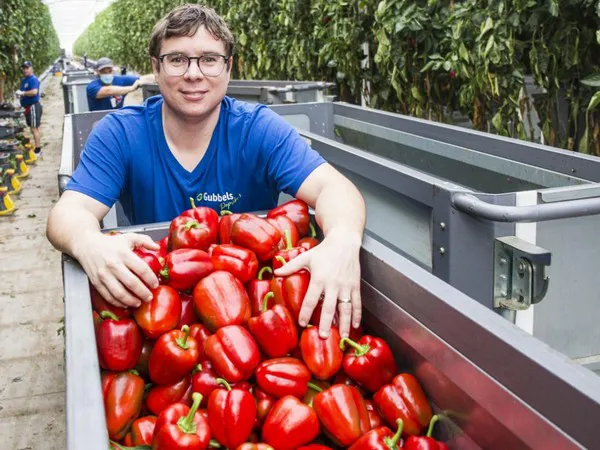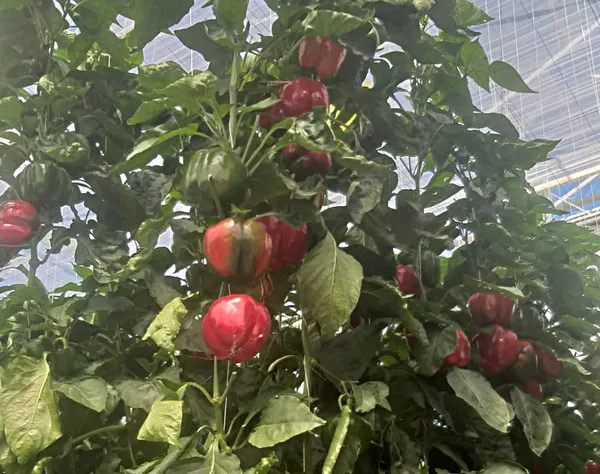The Dutch company Gubbels Kwekerijen's motto is 'On the way to energy-neutral cultivation.' Since 2010, it has been working on growing bell peppers in the most energy-efficient way possible. In these times of high energy prices, this is even more relevant. How does Gubbels Kwekerijen deal with this?
Annually, Gubbels Kwekerijen cultivates about 11 million kg of red and yellow bell peppers. "We have 37 hectares at three locations," says owner Erik Gubbels. "The bell pepper season runs from March through November. In December, we put the first new plants in the greenhouse, and roughly four months later, we harvest the first peppers. We trade all of the daily fresh products via the ZON growers cooperative."

Sustainable cultivation
Gubbels Kwekerijen is committed to balancing high-quality bell pepper production and energy-efficient cultivation. "We use six CHP (combined heat and power) units to generate the power, heat, and CO2 we need. When these units burn natural gas, it releases electricity, heat, and flue gases, which we convert into CO2."
"We use the heat and CO2 for our energy-efficient bell pepper cultivation. We supply the surplus power back into the grid. A 96% yield currently makes this one of the most sustainable cultivation methods for us. We also get power from a nearby biomass power plant that runs on waste wood chips," explains Erik.
Using residual heat
Gubbels has been focusing on energy-efficient farming for more than a decade. The experience and knowledge he has gained are especially handy with today's high energy prices. "We consider every aspect of bell pepper production and keep moving towards energy-neutral cultivation. We, thus, also use the residual heat. Also, the CHPs are cooled with water. We store this water in a large buffer tank during the day. At night, the warm water flows through the greenhouses via heating pipes."
"That creates a constant warm indoor climate, so our plants grow optimally while providing the general public with power. We also cultivate along with the weather, thanks to our computer-controlled system. We have a person who works full-time on this. He checks the weather every hour and responds accordingly. It's all in the details. For example, will it be cloudy in the next hour, and for how long? And what should we do?" Erik continues.

Automated harvesting and sorting
For all vegetables, the less handling, the less chance of damage. That applies to bell peppers too. Gubbels has therefore put its faith in innovative cultivation and processing techniques. The peppers are only touched by human hands when they are harvested. The follow-up process is automated.
"The harvested peppers are collected in containers. After harvesting, these full containers automatically travel to the processing hall via an induction line. At the sorting line, the peppers are sorted by color, size, and weight. We then custom-package them."
Solid cardboard is strong
The bell peppers are packed in, among other things, boxes. "In the peak season, we fill about 8,000 boxes a day. These have solid cardboard lids supplied by Smart Packaging Solutions. Solid cardboard is sturdy; that's why we chose it. Good quality packaging is, of course, essential for food safety," Erik continues. "We sell most of our peppers in the Netherlands and Germany."
"Naturally, it's vital that the boxes of bell peppers arrive at customers in good condition. The boxes can sometimes get damp in cold stores. That's an important reason why we choose solid cardboard lids - they can withstand this. Besides these good-quality lids, Smart Packaging Solutions is a reliable supplier. It's no wonder we've been working together for many years," Erik concludes.
 For more information:
For more information:
Gubbels Kwekerijen
21 Zonneveld
5993 SG, Maasbree, NL
Email: info@kwekerijgubbels.nl
Website: www.gubbelskwekerijen.nl
 Smart Packaging Solutions
Smart Packaging Solutions
120 Oude Baan
9200, Oudegem-Dendermonde, Belgium
Tel: +32 (0) 522 61 925
Email: info@smartpaso.com
Website: www.smart-packaging-solutions.com
